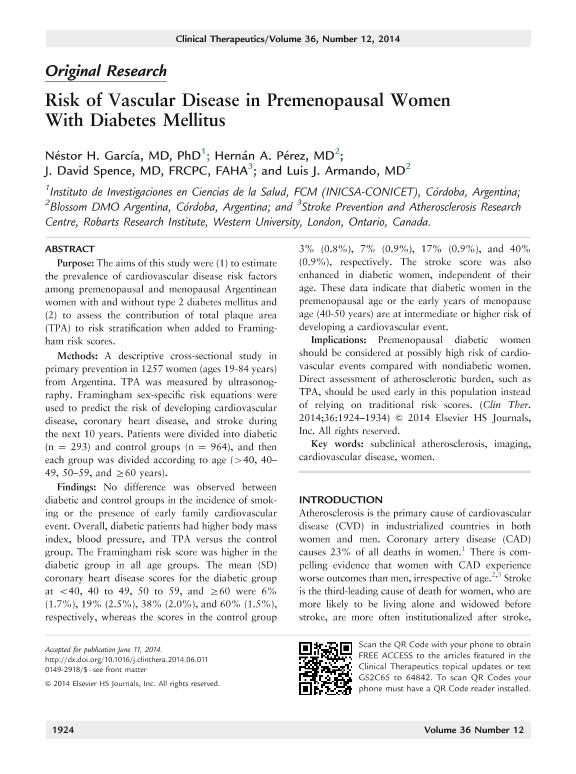Mostrar el registro sencillo del ítem
dc.contributor.author
Garcia, Nestor Horacio

dc.contributor.author
Pérez, H. A.
dc.contributor.author
Spence, J. D.
dc.contributor.author
Armando, L. J.
dc.date.available
2017-01-16T19:08:34Z
dc.date.issued
2014-12
dc.identifier.citation
Garcia, Nestor Horacio; Pérez, H. A.; Spence, J. D.; Armando, L. J.; Risk of vascular disease in premenopausal women with diabetes mellitus; Elsevier Science; Clinical Therapeutics; 36; 12; 12-2014; 1924–1934
dc.identifier.issn
0149-2918
dc.identifier.uri
http://hdl.handle.net/11336/11405
dc.description.abstract
Purpose: The aims of this study were (1) to estimate the prevalence of cardiovascular disease risk factors among premenopausal and menopausal Argentinean women with and without type 2 diabetes mellitus and (2) to assess the contribution of total plaque area (TPA) to risk stratification when added to Framingham risk scores.
Methods: A descriptive cross-sectional study in primary prevention in 1257 women (ages 19-84 years) from Argentina. TPA was measured by ultrasonography. Framingham sex-specific risk equations were used to predict the risk of developing cardiovascular disease, coronary heart disease, and stroke during the next 10 years. Patients were divided into diabetic (n = 293) and control groups (n = 964), and then each group was divided according to age (>40, 40–49, 50–59, and ≥60 years).
Findings: No difference was observed between diabetic and control groups in the incidence of smoking or the presence of early family cardiovascular event. Overall, diabetic patients had higher body mass index, blood pressure, and TPA versus the control group. The Framingham risk score was higher in the diabetic group in all age groups. The mean (SD) coronary heart disease scores for the diabetic group at <40, 40 to 49, 50 to 59, and ≥60 were 6% (1.7%), 19% (2.5%), 38% (2.0%), and 60% (1.5%), respectively, whereas the scores in the control group 3% (0.8%), 7% (0.9%), 17% (0.9%), and 40% (0.9%), respectively. The stroke score was also enhanced in diabetic women, independent of their age. These data indicate that diabetic women in the premenopausal age or the early years of menopause age (40-50 years) are at intermediate or higher risk of developing a cardiovascular event.
Implications: Premenopausal diabetic women should be considered at possibly high risk of cardiovascular events compared with nondiabetic women. Direct assessment of atherosclerotic burden, such as TPA, should be used early in this population instead of relying on traditional risk scores.
dc.format
application/pdf
dc.language.iso
eng
dc.publisher
Elsevier Science

dc.rights
info:eu-repo/semantics/openAccess
dc.rights.uri
https://creativecommons.org/licenses/by-nc-nd/2.5/ar/
dc.subject
Diabetes Mellitus
dc.subject
Subclinical Atherosclerosis
dc.subject
Cardiovascular Disease
dc.subject
Women
dc.subject.classification
Sistemas Cardíaco y Cardiovascular

dc.subject.classification
Medicina Clínica

dc.subject.classification
CIENCIAS MÉDICAS Y DE LA SALUD

dc.title
Risk of vascular disease in premenopausal women with diabetes mellitus
dc.type
info:eu-repo/semantics/article
dc.type
info:ar-repo/semantics/artículo
dc.type
info:eu-repo/semantics/publishedVersion
dc.date.updated
2017-01-13T19:47:10Z
dc.journal.volume
36
dc.journal.number
12
dc.journal.pagination
1924–1934
dc.journal.pais
Países Bajos

dc.journal.ciudad
Amsterdam
dc.description.fil
Fil: Garcia, Nestor Horacio. Consejo Nacional de Investigaciones Cientificas y Tecnicas. Centro Cientifico Tecnologico Cordoba. Instituto de Investigaciones en Ciencias de la Salud; Argentina
dc.description.fil
Fil: Pérez, H. A.. Blossom DMO; Argentina
dc.description.fil
Fil: Spence, J. D.. Western University; Canadá
dc.description.fil
Fil: Armando, L. J.. Blossom DMO; Argentina
dc.journal.title
Clinical Therapeutics

dc.relation.alternativeid
info:eu-repo/semantics/altIdentifier/doi/http://dx.doi.org/10.1016/j.clinthera.2014.06.011
dc.relation.alternativeid
info:eu-repo/semantics/altIdentifier/url/http://www.sciencedirect.com/science/article/pii/S0149291814003749
Archivos asociados
